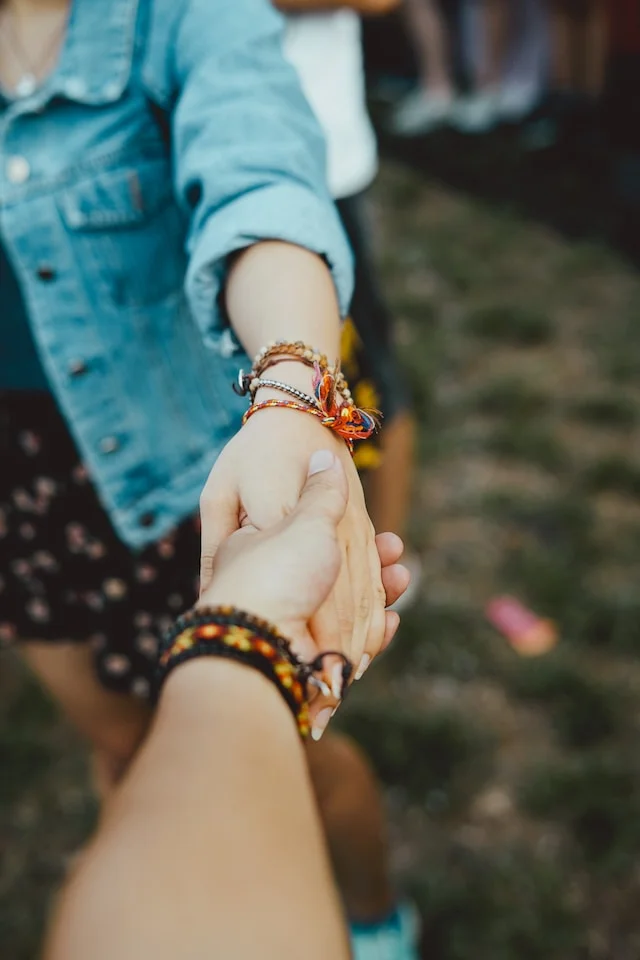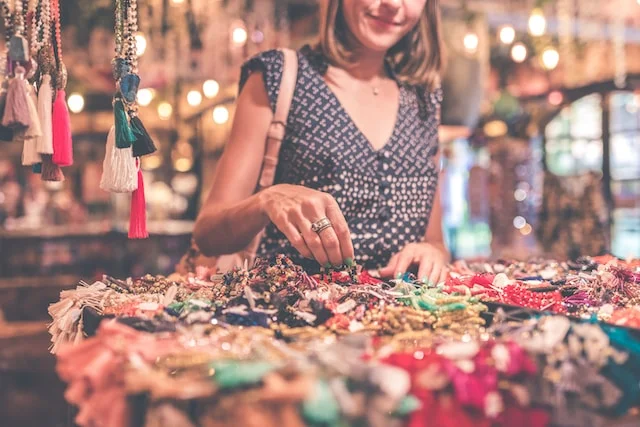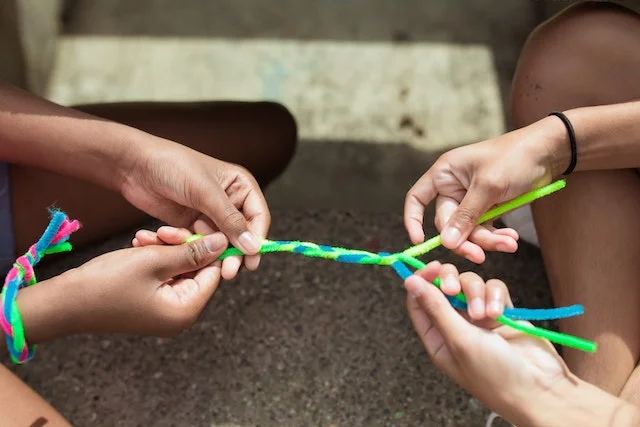Color Symbolism in Mental Health Bracelets
Have you ever noticed how everyone appears to be wearing a lot of colorful wrist candy these days? From charity bracelets to beaded besties, the small strips that wrap around your arms reveal a lot more stories than you realize, gals. It turns out that different colors have rich symbolic meanings, particularly when it comes to raising awareness about vital concerns like mental health. It’s amazing how much philosophy can fit on a tiny wrist, isn’t it?

Bracelet Colors And Their Meanings
Pink Bracelets
The pink bracelet has become a globally recognized symbol of breast cancer awareness. Pink is generally associated with femininity, hence, it is being utilized to promote education, fundraising, and awareness of the condition, which affects over 2 million women worldwide each year. The pink ribbon campaign first appeared in the early 1990s and has only grown since then.
Rainbow Bracelets
To represent LGBTQ support and advocacy, the rainbow bracelet plainly borrows from the rainbow pride flag. The bracelets represent oneness with the diversity of human sexuality and gender identity, much as the rainbow contains the diversity of light. They encourage equality, acceptance, and self-esteem.
Yellow Bracelets
These bracelets emphasize suicide prevention, honoring those who have died by suicide while also supporting people suffering from mental health disorders, sadness, and emotional distress that may lead to self-harm. Yellow represents hope and someone standing in the gap for people who are despairing.

Blue Bracelets
They raise bullying awareness, particularly among young people. Blue is frequently associated with stability, wisdom, and tranquility. The bracelets promote peaceful conflict resolution, safe schools, justice, and mentorship in order to avoid bullying-related violence.
Green Bracelets
The color green conveys messages about both mental wellness and the environment. In terms of mental health, green indicates rejuvenation, balance, and renewal in the face of disorders such as anxiety, depression, PTSD, and so on. Environmentally, the green wristbands are linked to natural preservation, sustainability, and wildlife conservation.
Purple Bracelets
Linked to mental health disorders such as PTSD (Post-Traumatic Stress Disorder) and Alzheimer’s disease. They promote awareness of these conditions and offer assistance to anyone who needs it.
Orange Bracelets
Orange bracelets are used to promote self-harm awareness initiatives. Every March, self-injury awareness month is observed in the United States, Canada, and Western Europe. It is customary to wear an orange ribbon or an orange wristband. Self-harm consciousness, sometimes known as Self-Injury Awareness Associations, works tirelessly to promote consciousness about self-harm. Writing the word LOVE on their arms, painting a butterfly on their wrists, and wearing orange ribbons and bracelets are all part of their efforts.
Reasons for Wearing Colored Bracelets
- Spread awareness discreetly
- Find community support
- Honor a loved one
- Encourage open dialogue
- Reduce stigma
- Show hope and recovery

How Awareness Wristbands are Used Today
While bracelet colors began as standalone symbols, the adorning of mental health charities has propelled these color-meaning combinations into the public in recent years. Many non-profits, organizations, and awareness campaigns have used colorful wristbands as a low-effort, high-impact method of educating the public.
For example, did you know that “Red Day” is celebrated on the first Friday of February every year? On this day, millions of people around the world wear red to initiate vital conversations about mental illness stigma and understanding. The act of banding together under the color red has a noticeable influence on this very real issue, both statistically and socially.
Awareness wristbands are widely used as instructional materials in schools around the United States. Teachers provide symbolic ally and instruction about prevalent illnesses such as anxiety, depression, OCD, and self-harm by handing out colorful wristwear emblazoned with phone helplines, websites for facts, or simply the colors’ messages. If even one youngster feels emboldened to seek help, the impact will be far-reaching.
Bracelets are frequently sold as fundraisers at music festivals and fairs. Attendees can proudly display both fashion and generosity for about a dollar. Because all earnings go to deserving mental health charities, wearing the bracelet becomes more than simply a bright accessory—it’s a walking demonstration of commitment to an essential movement.
Celebrities and influencers have also donated their celebrity to mental health wristband campaigns. From wearing significant pieces of wristwear to sharing personal struggle tales, these voices amplify messages of hope, rehabilitation, and stigma-fighting to enormous online and offline audiences. If awareness can be communicated on large social media platforms, more allies will be formed to support this noble cause.
What Is the Bracelet Project on TikTok and Mental Health Colors Meaning Explained
TikTok is one online community that has truly blown the conversation around the symbolism of bracelet colors. The #BraceletProject craze swept the social platform in 2021, further educating new generations about the emblems decorating their wrists or those of their classmates.
What Is TikTok’s Bracelet Project For?
The Bracelet Project promotes open, judgment-free discussions regarding mental health. Creators started building “bracelet dictionaries” to explain each hue and what it represents in terms of various problems, diagnoses, therapies, and more. Others began to share their own colorful stacks, along with anonymity, to represent their own experiences and conditions – whether permanent or temporary – without having to directly name them.
Through anonymity, the method made addressing such sensitive themes less scary. Viewers may be able to better understand their peers or inquire about how to support loved ones by using subtle symbolic cues rather than direct inquiries or assumptions. It also highlighted how pervasive disorders like as anxiety and sadness have become among young people.
Millions of people joined the talks and educated each other by allowing colored bracelets to do some of the vulnerable talking. Instead of being insensitive, the comments were filled with concern, understanding, and solidarity. Struggles were made a little less lonely by a colorful digital show of camaraderie.
So, whether through charities, schools, events, or social media challenges, the once-simple strings of color worn on wrists have morphed into potent vehicles propelling vital mental wellness debates forward every day. Their messages are now reaching a broader audience, which benefits significantly from improved understanding and empathy on issues that affect more lives than most people realize.

Conclusion
Finally, while bangles may appear to be simply accessories, their vivid inscriptions reflect far deeper ideologies. Discussion starters went global from little more than hope and imaginative adolescent brains, thanks to concerted work, compassionate internet communities, and ordinary symbols. And the widespread transmission of empathy and awareness unquestionably benefits innumerable people.
Understanding, no matter how big or small, lifts others on lonely journeys. Together, we must continue to boost each other up in any way we are able and ensure that no one feels isolated by their challenges, whether inside their own circle or strangers halfway around the world. Even from afar, the support signifies the cosmos. So, keep up the loving sistahood and unravel the powerful poetry beneath your pops of poppin’ poetry, girls. You never know who you might make someone’s day a little brighter!
FAQs
RED – heart disease, stroke, DARE/substance abuse, AIDS, MADD. MAROON – multiple myeloma, sickle cell disease, brain aneurysm. ORANGE – kidney & leukemia cancer, Multiple Sclerosis, ASPCA, motorcycle safety, world hunger, self harm awareness. YELLOW – sarcoma & bone cancer, support our troops/POWs/MIA, suicide.
Red bracelets represents anorexia, purple is for bulimia, blue and black are for self injury. They’re shipped in discreet packages so parents won’t notice.
Blue wristbands are one of the most popular colors adopted by organisations on their charity and awareness bracelets. Their meanings range from diseases like colon and colorectal cancer to social issues like animal abuse and domestic violence. Different shades of blue are also synonymous with other conditions.
Black wristbands display mourning and advocate sleep disorders. They’re also used in conjunction with white wristbands to promote Black Lives Matter. Black bracelets may also represent prisoners of war, 9/11, gang prevention, skin cancer research or counter-culture movements.
Red: specific allergies. Yellow : for patients at risk of falling. Purple: do not resuscitate.
green ribbon
The green ribbon plays an important role in the world as it represents mental health awareness. Too often, mental health is overlooked. The reason might be a stigma people have against receiving care for past traumas and addressing present issues.
Sources:
- Wristband Color Meanings
- What is the Bracelet Project on TikTok? Meaning and colors explained
- Awareness Wristbands: Colors and Meanings
- Understanding The Meaning Behind The Color Bracelet: Exploring Self-Harm And Mental Health Resources
- Awareness Wristbands and the Meaning Behind the Colors
- Wristband Color Meanings
- Explained What Is The Bracelet Project On Tiktok And Mental Health Colors Meaning Explained
- Mental Health Awareness
- Awareness Wristband Colors
- The Different Meanings Behind Coloured Wristbands
- Color Coded Braclets
